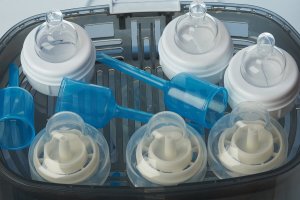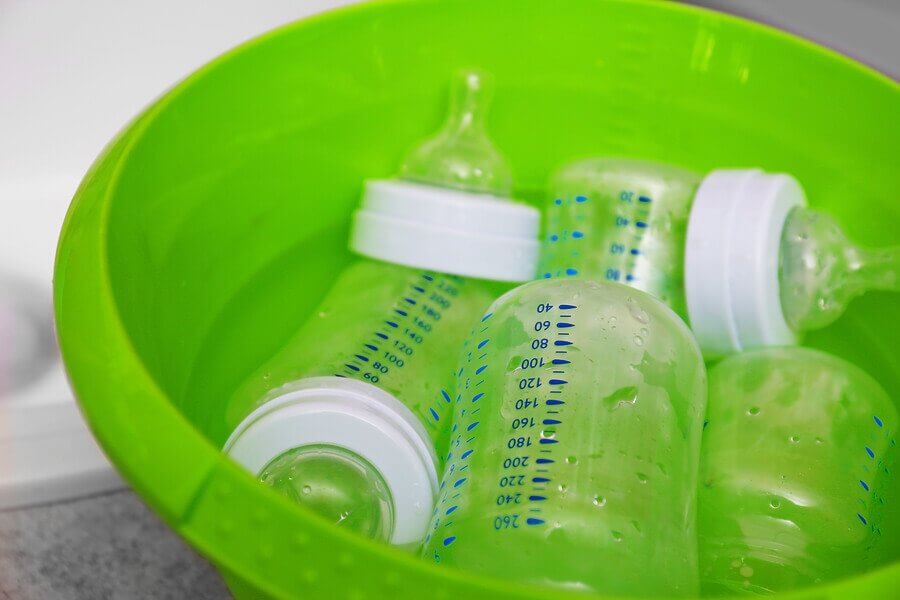The Different Functions of Bottle Sterilizers

Mothers always try to provide their children with a germ-free environment, especially for sensitive items that are used every day. Learn about the different functions of bottle sterilizers and why they’re the main allies of hygiene for babies.
Like pacifiers, bottles are the most common objects that go in babies’ mouths. Therefore, don’t leave their cleanliness up to chance. If you’re too careless, it could open the door to possible infections.
With the arrival of your baby, you need to be aware that when breastfeeding is supplemented with other foods and the baby uses bottles, you need to sterilize them before every use. This eliminates possible bacteria that may have gotten stuck thanks to food residue and other elements.
Technology always offers more practical alternatives to facilitate daily life, including mothers’ tasks. An example of this is bottle sterilizers, an item that’s becoming more common on the market. In fact, it’s indispensable in the homes of modern mothers.
Without this device, you can still make sure to get rid of germs without any problems. Although at first it might seem complicated to handle, it’s actually quite simple.
Nowadays, there are multifunctional models that make this task very easy. They’re a great tool to keep bottles sanitized.

How do bottle sterilizers work?
Among the many things bottle sterilizers do, the main function is to eliminate germs. To do this, they use different methods. Some of the most common ones available on the market are:
Cold system
These sterilizers are relatively inexpensive and simple to use. They also have the advantage of using electricity to work. This model works by dissolving pills in cold water to eliminate bacteria.
Microwave
This is one of the favorites for its price, size and simplicity to use. You place it in the microwave directly for a few minutes. Then, steam quickly and effectively removes impurities or bacteria.
“Bottles are the most common objects that go in babies’ mouths. Therefore, don’t leave their cleanliness up to chance.”
Electric
This costs a little more money, but its practicality and speed have made many mothers love it. For many, this model is the best choice. The water heats to a high temperature. The steam it makes removes bacteria from the bottles.
Currently, water vapor has become the most used method thanks to its effectiveness to eliminate any dirt and bacteria.
It has even gotten rid of toxic substances with chemical additives. These sterilizers use it for those reasons, in addition to its speed and low cost.
Something that you must take into account is that the function of bottle sterilizers is to disinfect, not wash. You should only use these devices after thoroughly cleaning all parts of the bottle, and after removing milk or other food.
Other functions of bottle sterilizers
Although it’s the main purpose, bottle sterilizers don’t just get rid of germs. Many electric models come with a variety of features to make mothers’ lives easier.
They use new technology to help prepare the bottles easily and quickly. Some even have an automatic shutdown function, intelligent design and multi-purpose features.

The multi-purpose models don’t just sterilize baby bottles. Additionally, they take advantage of their ability to disinfect other small accessories like breast pumps or pacifiers. Likewise, steam allows the bottles to be heated in a practical way.
Another remarkable feature is that in some models, you can cook and heat steamed meals. This will be very useful when the baby begins to eat solid foods. Remember, with this method of sterilization, you can better preserve food’s nutrients.
Definitely, good bottle sterilizers will become your best ally against germs. You only have to decide what system you want, what size, and what characters and features fit your needs. With these tips, you can find the perfect model for you.
Mothers always try to provide their children with a germ-free environment, especially for sensitive items that are used every day. Learn about the different functions of bottle sterilizers and why they’re the main allies of hygiene for babies.
Like pacifiers, bottles are the most common objects that go in babies’ mouths. Therefore, don’t leave their cleanliness up to chance. If you’re too careless, it could open the door to possible infections.
With the arrival of your baby, you need to be aware that when breastfeeding is supplemented with other foods and the baby uses bottles, you need to sterilize them before every use. This eliminates possible bacteria that may have gotten stuck thanks to food residue and other elements.
Technology always offers more practical alternatives to facilitate daily life, including mothers’ tasks. An example of this is bottle sterilizers, an item that’s becoming more common on the market. In fact, it’s indispensable in the homes of modern mothers.
Without this device, you can still make sure to get rid of germs without any problems. Although at first it might seem complicated to handle, it’s actually quite simple.
Nowadays, there are multifunctional models that make this task very easy. They’re a great tool to keep bottles sanitized.

How do bottle sterilizers work?
Among the many things bottle sterilizers do, the main function is to eliminate germs. To do this, they use different methods. Some of the most common ones available on the market are:
Cold system
These sterilizers are relatively inexpensive and simple to use. They also have the advantage of using electricity to work. This model works by dissolving pills in cold water to eliminate bacteria.
Microwave
This is one of the favorites for its price, size and simplicity to use. You place it in the microwave directly for a few minutes. Then, steam quickly and effectively removes impurities or bacteria.
“Bottles are the most common objects that go in babies’ mouths. Therefore, don’t leave their cleanliness up to chance.”
Electric
This costs a little more money, but its practicality and speed have made many mothers love it. For many, this model is the best choice. The water heats to a high temperature. The steam it makes removes bacteria from the bottles.
Currently, water vapor has become the most used method thanks to its effectiveness to eliminate any dirt and bacteria.
It has even gotten rid of toxic substances with chemical additives. These sterilizers use it for those reasons, in addition to its speed and low cost.
Something that you must take into account is that the function of bottle sterilizers is to disinfect, not wash. You should only use these devices after thoroughly cleaning all parts of the bottle, and after removing milk or other food.
Other functions of bottle sterilizers
Although it’s the main purpose, bottle sterilizers don’t just get rid of germs. Many electric models come with a variety of features to make mothers’ lives easier.
They use new technology to help prepare the bottles easily and quickly. Some even have an automatic shutdown function, intelligent design and multi-purpose features.

The multi-purpose models don’t just sterilize baby bottles. Additionally, they take advantage of their ability to disinfect other small accessories like breast pumps or pacifiers. Likewise, steam allows the bottles to be heated in a practical way.
Another remarkable feature is that in some models, you can cook and heat steamed meals. This will be very useful when the baby begins to eat solid foods. Remember, with this method of sterilization, you can better preserve food’s nutrients.
Definitely, good bottle sterilizers will become your best ally against germs. You only have to decide what system you want, what size, and what characters and features fit your needs. With these tips, you can find the perfect model for you.
All cited sources were thoroughly reviewed by our team to ensure their quality, reliability, currency, and validity. The bibliography of this article was considered reliable and of academic or scientific accuracy.
- Dichtl K, Koeppel MB, Wallner CP, Marx T, Wagener J, Ney L. Food poisoning: an underestimated cause of Boerhaave syndrome. Infection. 2020 Feb;48(1):125-128
- Brown A. Breastfeeding as a public health responsibility: a review of the evidence. J Hum Nutr Diet. 2017 Dec;30(6):759-770.
This text is provided for informational purposes only and does not replace consultation with a professional. If in doubt, consult your specialist.








